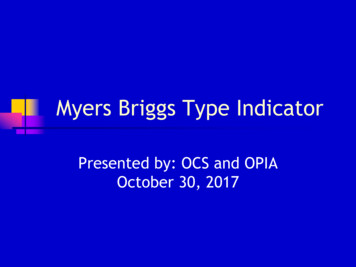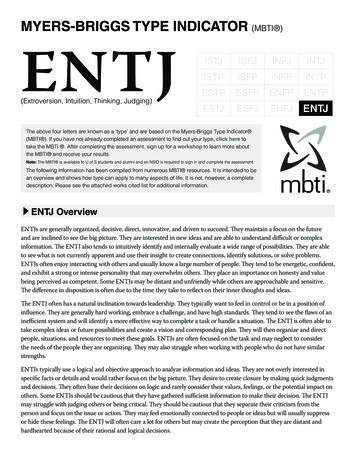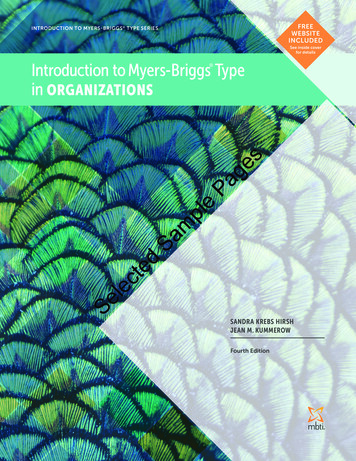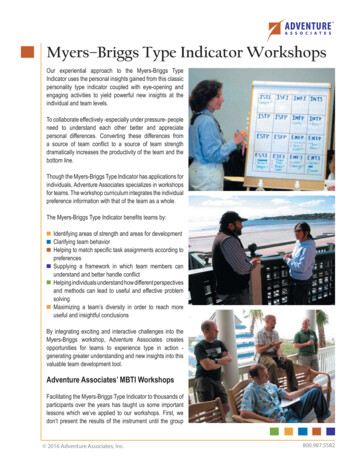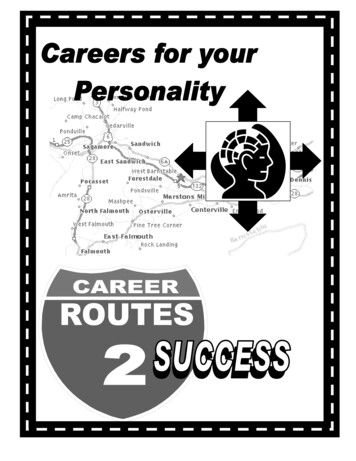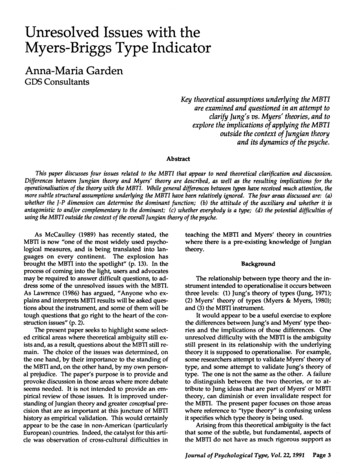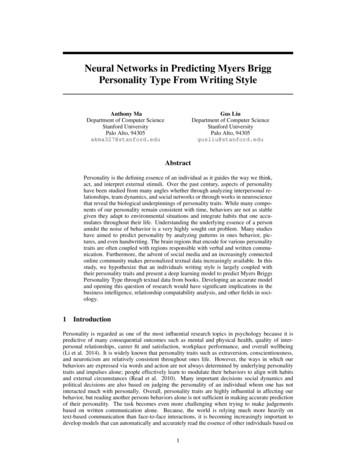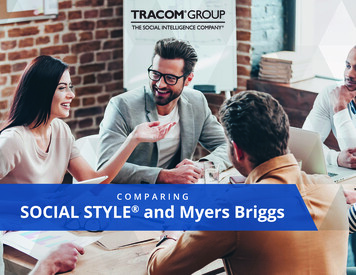
Transcription
WH AT I S TH E DI F F ER EN CE B ETW EEN P E R S O N ALI T Y P R O FILE S A N D SO C IAL STY LE ?This is a common question. More specifically, people want to know how to compare SOCIAL STYLE to popular personalityprofiles such as the Myers-Briggs Type Indicator (MBTI ). What are the similarities and differences?In this paper we explain how Style and MBTI relate to one another. Myers-Briggs Type Indicator (MBTI ) is a registeredtrademark of CPP. The TRACOM Group has no affiliation with CPP or MBTI , and neither CPP nor any of the authors,creators or representatives of MBTI have reviewed or approved this paper.COMPARING SOCIAL STYLE & MYERS-BRIGGS2
Extraversion and Introversion are often called attitudes. Ingeneral, extraverts are action-oriented and get their energyfrom interacting with people, whereas introverts are thoughtoriented and get their energy from spending time alone.Overview of the Myers-Briggs Type Indicator Sensing and Intuition are ways people perceive the world.The MBTI is designed to measure psychological preferences inThey describe how information is taken in and interpretedhow people perceive the world around them and make decisions.by individuals. People who prefer sensing rely on informationBased on the theoretical work of Carl Jung, the questionnaire andthat is tangible and concrete. On the other hand, those whoprofile were originally developed by Katherine Cook Briggs andprefer intuition rely on information that is more abstract orher daughter, Isabel Briggs Myers.theoretical.The MBTI describes personality using four pairs of oppositepreferences, called dichotomies:Thinking and Feeling are decision-making functions. Thosewho prefer thinking make decisions from a more detachedstandpoint, evaluating the decision with a logical set of rules. Extraversion (E) or Introversion (I)Those who prefer feeling make decisions by associating or Sensing (S) or Intuition (N)empathizing with the situation, trying to achieve harmony Thinking (T) or Feeling (F) Judging (J) or Perceiving (P)Individuals are described by a combination of these fourdichotomies. For example, a person can be described as ESFP,INTJ, and so on.and consensus, and considering the needs of the peopleinvolved.Finally, the MBTI describes people’s preference for eitherJudging or Perceiving when relating to the outside world.Individuals with a preference for judgment display theirpreferred judging function (Thinking or Feeling). For example,TJ types appear logical, and FJ types as empathetic. Individualswho prefer perception show their perceiving function (Sensingor Intuition). For example, SP types appear as concrete andNP types as abstract.COMPARING SOCIAL STYLE & MYERS-BRIGGS3
DifferencesThere are several important differences between the MBTI andothers view a person’s behavior. This distinction is evident in theSOCIAL STYLE. First, the MBTI and SOCIAL STYLE are based onways in which the two measurement systems operate. The MBTIdifferent theoretical models. The MBTI is based on Carl Jung’sis a self-report instrument, whereas SOCIAL STYLE is offered as apersonality theory, while SOCIAL STYLE is based on behavioralmulti-rater instrument where others’ observations are essential.psychology. The MBTI focuses on personality types and individualThe focus on intrapersonal understanding of personality (MBTI)preferences, whereas SOCIAL STYLE describes patterns of behavior.versus interpersonal awareness of behavior (Style) is a keyBoth models have been extensively researched and have been putdifference between the two models.to practical use for decades.Another important distinction involves Versatility, a part of theThe two models relate to different aspects of the self: MBTI onSOCIAL STYLE Profile that measures interpersonal effectiveness.intrapersonal functioning and SOCIAL STYLE on interpersonalMuch of the emphasis on interacting more effectively with others isfunctioning. The MBTI is focused on internal thoughts and feelings,achieved through the application of Versatility. Versatility consistswhile SOCIAL STYLE is focused on social relationships. The MBTIof four elements: Image, Presentation, Competence, and Feedback.provides intrapersonal insight about a person’s personalityEach of these elements provides information about personalpreferences; SOCIAL STYLE gives interpersonal insight into howbehavior and how to improve interpersonal effectiveness.COMPARING SOCIAL STYLE & MYERS-BRIGGS4
SimilaritiesThere are some superficial similarities in how MBTI and SOCIALSTYLE are reported. It is often these similarities that lead peopleto ask about the connection between Style and the MBTI. TheMBTI describes 16 distinct types. Coincidentally, SOCIAL STYLE alsodescribes 16 Style distinctions; however, individuals are categorizedinto four broad Styles, each with four sub-quadrants. The subquadrants describe subtle differences within each of the four Styles.For example, a C3 Amiable person has slightly different behavioralpatterns than a D4 Amiable person.There are also some characteristic similarities among the MBTI typesand Styles. For example, the INTJ type is similar in some ways to theAnalytical Style. Both are logical, organized, methodical, and critical.The Analytical person keeps thoughts internal, is precise, emotionallycontrolled, and needs to logically analyze issues before makingdecisions. These descriptions are similar to the INTJ descriptions.The fundamental distinction between these two descriptions isthat SOCIAL STYLE is derived from people’s perceptions of anotherperson’s outward behavior, while the MBTI types are derived fromself-perception of needs and preferences. This is an importantdistinction since internal preferences and intentions are not alwaysrelated to behavior as seen and interpreted by others. An INTJ can beseen as Analytical or any other Style.COMPARING SOCIAL STYLE & MYERS-BRIGGS5
Mapping SOCIAL STYLE to MBTIThe MBTI types have been mapped to interaction styles, which is aindicate otherwise. For example, though an INTJ is predicted toconcept similar to SOCIAL STYLE. Graph 1 on page 7 displays theprofile as a D1 Analytical, if such a person is in a role that requiresMBTI types in relation to the 16 SOCIAL STYLE sub-quadrants. Thea great deal of activity and interaction with others, then othermost obvious similarity exists along the Extraversion/Introversionpeople’s observations may cause his or her profile to corresponddimension. The Tell Assertive styles, Driving and Expressive, aremore closely to a C1 or B1 (Analytical/Driving). As we notedextraverted and the Ask Assertive styles, Amiable and Analytical, arepreviously, people’s behavior does not always correspond withintroverted.their self-perceptions.A similar pattern exists on the Responsiveness dimension inA person’s MBTI and SOCIAL STYLE results are most likely torelation to the MBTI Thinking/Feeling dimension. With only somecorrespond with the map when their self-perception is clearlyexceptions, the Controlled Responsive styles, Analytical andaligned with their outward behavior. In other words, when the MBTIDriving, are Thinking and the Emote Responsive styles, Amiable andprofile, which is a measure of internal preferences, clearly relatesExpressive, are Feeling.to how that person behaves towards others, then there is a higherWe want to point out that this map is not empirical; there is noscientific research behind this. It was based on the judgmentand experiences of personality researchers. The mappings arereasonable; however it is impossible to determine whether the twoprofiles would correspond with one another to such a degree if thisprobability that the map will be accurate. TRACOM’s research onSOCIAL STYLE has shown that self-perception of behavior is onlythe same as others’ perception approximately 50% of the time.Likewise, how people feel about themselves is often not the sameas how they behave towards others.were tested on real people. On the contrary, our experiences wouldCOMPARING SOCIAL STYLE & MYERS-BRIGGS6
SummaryThe Myers-Briggs Type Indicator and SOCIAL STYLE describe twoGRAPH 1: LI KELY M AP P I NG OF M B T I T Y PESTO S OCIAL STYLEIt is particularly enlightening for helping people understand theirExpressive: ENTP, ENFP, ESFJ, ESFPpreferences. For example, it can be useful for career and occupationAmiable: ISFJ, ISFP, INFP, INTPplanning, helping to insure a good fit between a person and aAnalytical: INFJ, INTJ, ISTJ, ISTPprofession.12INTJISTPISTJCO NTRO L SAN ALYTIC ALCINFJD R IV IN GA critical difference between SOCIAL STYLE and Myers-Briggs TypeBAIndicator is the ability of participants to understand and apply theENTJESTP1ESTJENFJ2TEL L SINTPISFPconcepts of each model. Research from Colorado State University andRegis Learning Solutions found that the TRACOM Social Style trainingmodel is easier to understand and use than either DiSC or Myers-Briggs.A SK S3more detailed view of the person than either could alone. The MBTIcan be useful for understanding personal preferences and motivations.Driving: ENTJ, ESTJ, ESTP, ENFJDdistinct aspects of a person. Together, these two pictures provide aENTPESFP3The study evaluated more than 200 people participating in trainingprograms featuring the DiSC model from Inscape Publishing, the MBTImodel from CPP, Inc., and the SOCIAL STYLE model from the TRACOMGroup. It found that while participants in all three programs held very4ISFJINFPCCAMIAB LEEM OTESpositive reactions to the training programs, participants in Style trainingESFJENFPBA4EX PR ES S IV Escored significantly higher in terms of understanding and retainingcourse concepts and in using those skills to understand and relateeffectively with others. Read more about this study HERE .SOCIAL STYLE is most effective for understanding how others see us,and also for understanding how to interact most effectively with othersbased on their Styles. Versatility adds to this understanding by providingpragmatic techniques for increasing interpersonal effectiveness.COMPARING SOCIAL STYLE & MYERS-BRIGGS7
About the AuthorCA S EY M U L QU EEN , PH. D .Senior Director of Learning & DevelopmentCasey Mulqueen oversees the research and development of TRACOM’s various assessmentinstruments and products. He has experience developing a wide variety of assessments such aspersonality inventories, 360-degree feedback programs, performance appraisal systems, andemployee engagement programs. His expertise in cross-cultural assessment and norming has helpedensure that TRACOM’s global surveys are valid and reliable throughout the world. He is a writerwho has authored a variety of materials including books, book chapters, and peer-reviewed journalarticles. Casey has an M.S. in clinical psychology and a Ph.D. in industrial/organizational psychology.Myers-Briggs Type Indicator (MBTI ) is a registered trademark of CPP. The TRACOM Group has no affiliation with CPP or MBTI , and neither CPP nor any of the authors,creators or representatives of MBTI have reviewed or approved this paper.COMPARING SOCIAL STYLE & MYERS-BRIGGS8
ABOUT[WHY we do]We believe that improving peoples’ understanding ofthemselves and others makes the world a better place.[WHAT we do]We synthesize our discoveries into actionable learning andresources that improve an individual’s performance in all partsof their lives. We call this Social Intelligence.[HOW we do it]Through research and experience we uncover the hiddenbarriers to individuals achieving their maximum potential andidentify how to help overcome them.For more information, visit WWW.TRACOMCORP.COM orcall (303) 470-4900 — (800) 221-2321 (U.S. only)
Overview of the Myers-Briggs Type Indicator The MBTI is designed to measure psychological preferences in how people perceive the world around them and make decisions. Based on the theoretical work of Carl Jung, the questionnaire and profile were originally developed by Katherine Cook Briggs

